中国古建筑(英文)
- 格式:pptx
- 大小:2.17 MB
- 文档页数:3
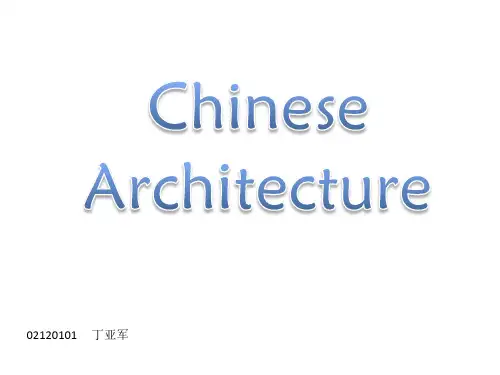

中国古典园林---- c lassical Chinese garden中国传统园林---- t raditional Chinese garden中国古代园林---- a ncient Chinese garden中国山水园------ C hinese mountain and water garden帝王宫苑----- imperial palace garden皇家园林----- royal garden私家园林----- private garden江南园林-------- g arden on the Yangtze Delta西方古典园林-------- western classical garden英国式园林------------- English style garden中英混合式园林--------- Anglo-Chinese style garden意大利式园林----------- Italian style garden西班牙式园林----------- Spainish style garden法兰西式园林----------- French style garden勒诺特尔式园林--------- Le Notre\'s style garden文艺复兴庄园------------- Renaissance style garden洛可可式园林--------------- Rococo style garden巴洛克式园林------------- Baroque style garden庄园---------------- manor,villa garden廊柱园-------------- peristyle garden,patio绿廊---------------- xystus迷阵---------------- maze,labyrinth灵囿---------------- Ling You Hunting Garden 周代术语灵沼--------- Ling Zhao Water Garden 周代术语灵台--------- Ling Tai Platform Garden 周代术语阿房宫------- E-Pang Palace 秦代术语上林苑---------- S hang-Lin Yuan 汉代术语未央宫---------- W ei-Yang Palace 汉代术语洛阳宫---------- L uoyang Palace 魏代术语华清宫---------- H ua-Qing Palace 唐代术语艮岳------------ G en Yue Imperial Garden 宋代术语圆明园---------- Y uan-Ming Yuan Imperial Garden颐和园------------ Yi-HE Yuan Imperial Garden承德避暑山庄-------- Chengde Imperial Summer Resort苏州园林------------ Suzhou traditional garden悬园------ Hanging Garden 又称“悬空园” ,“架高园” 。

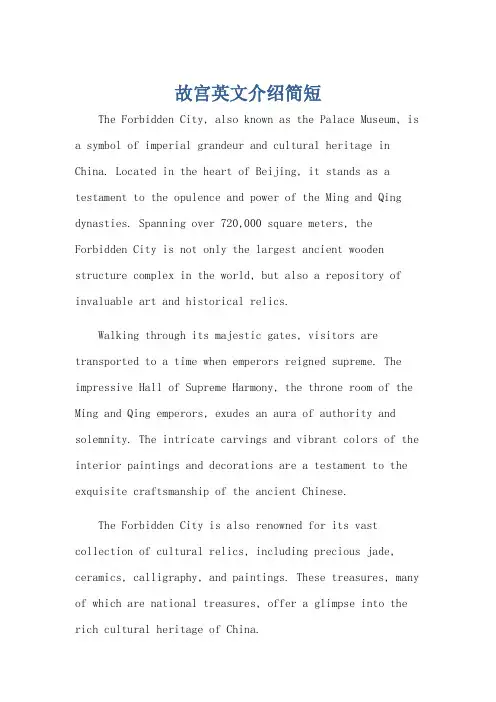
故宫英文介绍简短The Forbidden City, also known as the Palace Museum, is a symbol of imperial grandeur and cultural heritage in China. Located in the heart of Beijing, it stands as a testament to the opulence and power of the Ming and Qing dynasties. Spanning over 720,000 square meters, the Forbidden City is not only the largest ancient wooden structure complex in the world, but also a repository of invaluable art and historical relics.Walking through its majestic gates, visitors are transported to a time when emperors reigned supreme. The impressive Hall of Supreme Harmony, the throne room of the Ming and Qing emperors, exudes an aura of authority and solemnity. The intricate carvings and vibrant colors of the interior paintings and decorations are a testament to the exquisite craftsmanship of the ancient Chinese.The Forbidden City is also renowned for its vast collection of cultural relics, including precious jade, ceramics, calligraphy, and paintings. These treasures, many of which are national treasures, offer a glimpse into the rich cultural heritage of China.Moreover, the Forbidden City serves as an important educational and research center, attracting scholars and tourists alike. Its preservation and restoration efforts have been commended worldwide, ensuring that this magnificent complex remains a vibrant and living part of China's historical and cultural landscape.In conclusion, the Forbidden City is not only ahistorical monument but also a symbol of China's proud past and vibrant present. Its grandeur and beauty continue to inspire and awe visitors from all corners of the world.**故宫英文介绍简短**故宫,又称紫禁城,是中国皇权的象征与文化遗产的瑰宝。
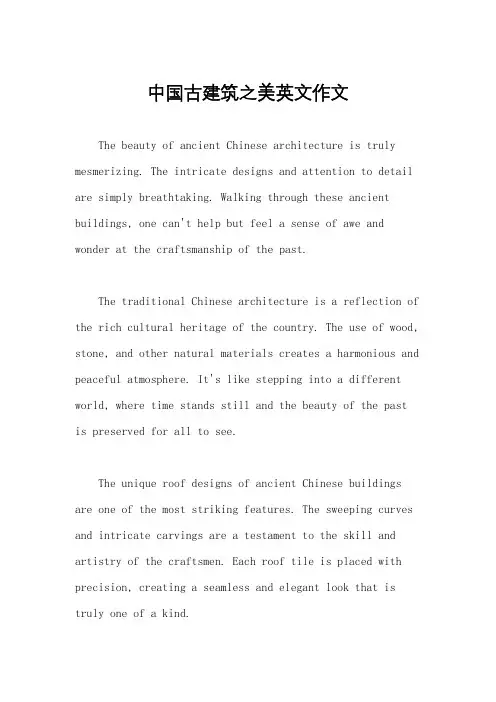
中国古建筑之美英文作文The beauty of ancient Chinese architecture is truly mesmerizing. The intricate designs and attention to detail are simply breathtaking. Walking through these ancient buildings, one can't help but feel a sense of awe and wonder at the craftsmanship of the past.The traditional Chinese architecture is a reflection of the rich cultural heritage of the country. The use of wood, stone, and other natural materials creates a harmonious and peaceful atmosphere. It's like stepping into a different world, where time stands still and the beauty of the past is preserved for all to see.The unique roof designs of ancient Chinese buildings are one of the most striking features. The sweeping curves and intricate carvings are a testament to the skill and artistry of the craftsmen. Each roof tile is placed with precision, creating a seamless and elegant look that is truly one of a kind.The use of symbolism in ancient Chinese architecture is also fascinating. From the placement of certain elements to the use of colors and patterns, every detail has a deeper meaning. It's like a language of its own, telling stories and conveying beliefs through the design of the buildings.The sense of harmony and balance in ancient Chinese architecture is truly remarkable. The careful placement of buildings, courtyards, and gardens creates a sense of tranquility and peace. It's a reminder of the importance of living in harmony with nature and the world around us.In conclusion, the beauty of ancient Chinese architecture is something that must be experienced firsthand. It's a journey through time and culture, a glimpse into the rich history and traditions of the Chinese people. The intricate designs, symbolism, and sense of harmony all come together to create something truly extraordinary.。
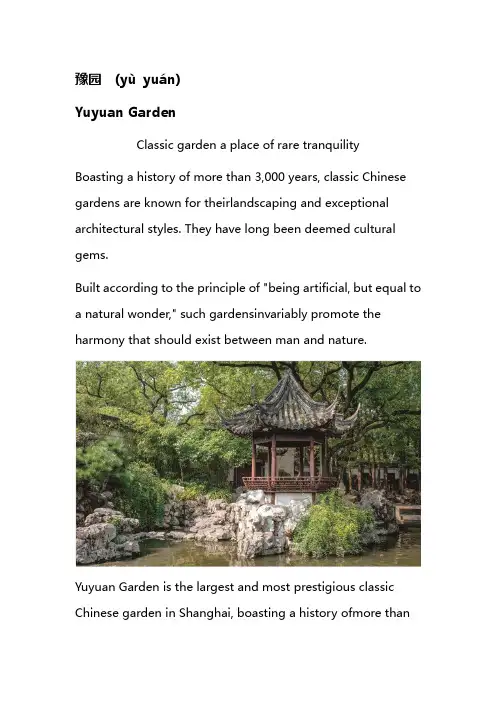
豫园(yùyuán)Yuyuan GardenClassic garden a place of rare tranquility Boasting a history of more than 3,000 years, classic Chinese gardens are known for theirlandscaping and exceptional architectural styles. They have long been deemed cultural gems.Built according to the principle of "being artificial, but equal to a natural wonder," such gardensinvariably promote the harmony that should exist between man and nature.Yuyuan Garden is the largest and most prestigious classic Chinese garden in Shanghai, boasting a history ofmore than450 years.Among them, Yuyuan Garden is the largest and most prestigious one in Shanghai, boasting ahistory of more than 450 years.The idea of building the garden was first conceived by Pan Yunduan in 1559. Pan was the son ofPan En, a minister of justice during the Ming Dynasty (1368–1644). The son decided to create agarden shortly after he failed the imperial examination.Pan picked the family's vegetable garden in the northeast of the Old City of Shanghai as the sitefor the project. But soon after construction began, Pan was appointed chief secretary of remoteSichuan in southwest China. The garden was not completed until Pan returned to Shanghainearly 20 years later. But before Pan died he had squandered most of his wealth and had to sell his lands andproperties to make ends meet. His granddaughter's husband inherited Yuyuan Garden. Through the years it changed hands several times and was used as the British army'sheadquarters during the First Opium War (1840–1842) and the Small Swords Society during theTaiping Rebellion (1851–1864).It also suffered severe damage during these occupations and later was further ruined byJapanese invaders in 1942.It was not until the late 1950s that the garden was fully repaired by the Shanghai government.Like other classic Chinese gardens, Yuyuan Garden —listed as a key historical site under stateprotection in 1982 —is known for its miniature landscapes comprising ponds, rocks, trees andflowers.It also houses a variety of halls, pavilions, towers and bridges. The garden is enclosed by a long white wall with five dragons made of black tiles crawling alongits top.In the center of the garden stands a very precious rock from nearby Taihu Lake. Known asYulinglong, or Exquisite Jade, the rock weighs about three tons and is reputed to be one of thetop three ancient "Taihu Rocks" in the Yangtze River Delta.Another attraction in Yuyuan is the zigzag bridge spanning a large lotus pond. Called Jiuqu Qiao,or Nine-Bend Bridge, it leads to the garden's entrance. In the middle of the pond and next to thebridge is a teahouse popular with visitors.Among the buildings in the garden, Dianchun Hall, or the Spring Heralding Hall, was once usedby the leader of the Small Swords Society as its headquarters.The hall was first built in 1820 by a merchant from Fujian Province.In addition to richly painted beams and doors and windows decorated with vivid woodsculptures, the hall faces a small stage, which stands partly in the surrounding water.Jiuqu Qiao, or Nine-Bend Bridge, leads to the garden's entrance. In the middle of the pond and next to thebridge is a teahouse popular with visitors.On the walls that divide the gardens into different scenic areas, there are a number of latticewindows. Such ornamental windows are frequently employed in Chinese gardens to create theeffect of "each window having its own view" and "one scenic view in another."In the garden, there are also a few waterside pavilions which provide visitors a place to rest andtake in the sights.Partly built on stilts above the water, such waterside pavilions are also an ideal location to look atlotus flowers when inseason or watch the fish leisurely swimming in the pond.The garden is enclosed by a long white wall with five dragons made of black tiles crawling along its top.Pictorial dictionary·水榭(shuǐxiè) waterside pavilionWaterside pavilions are common in classic Chinese gardens.Built partly on stilts above the water, a waterside pavilion is designed to provide travelers orvisitors a place to rest and take in the surrounding sights.On the water side, there is usually a long bench with a low railing, where people can sit and gazeat the water plants such as lotus flowers or watch fish swimming in the pond.Such pavilions usually feature gable and hip roofs with flying eaves and richly decorated windowsextending all the way to the floor.They are also designed with salient horizontal lines in order to create harmony with the surfaceof the water.。
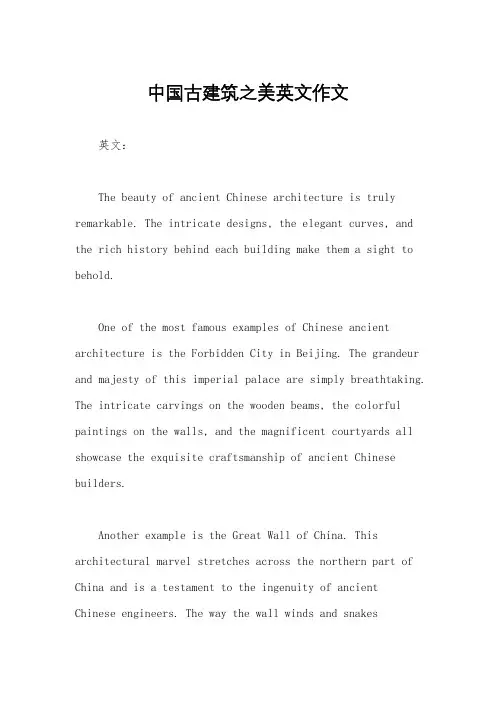
中国古建筑之美英文作文英文:The beauty of ancient Chinese architecture is truly remarkable. The intricate designs, the elegant curves, and the rich history behind each building make them a sight to behold.One of the most famous examples of Chinese ancient architecture is the Forbidden City in Beijing. The grandeur and majesty of this imperial palace are simply breathtaking. The intricate carvings on the wooden beams, the colorful paintings on the walls, and the magnificent courtyards all showcase the exquisite craftsmanship of ancient Chinese builders.Another example is the Great Wall of China. This architectural marvel stretches across the northern part of China and is a testament to the ingenuity of ancient Chinese engineers. The way the wall winds and snakesthrough the rugged terrain is a feat of engineering thatstill astounds visitors today.In addition to these famous landmarks, there are countless traditional Chinese houses, temples, and gardens that also showcase the beauty of ancient Chinese architecture. The elegant curved roofs, the intricatelattice windows, and the serene courtyards all reflect the harmony and balance that are central to Chinesearchitectural principles.The use of traditional materials such as wood, stone, and clay, as well as the incorporation of natural elements like water and plants, further enhance the beauty ofancient Chinese architecture. The attention to detail and the emphasis on harmony with nature make these buildingsnot only aesthetically pleasing but also deeply meaningful.中文:中国古建筑之美确实令人叹为观止。
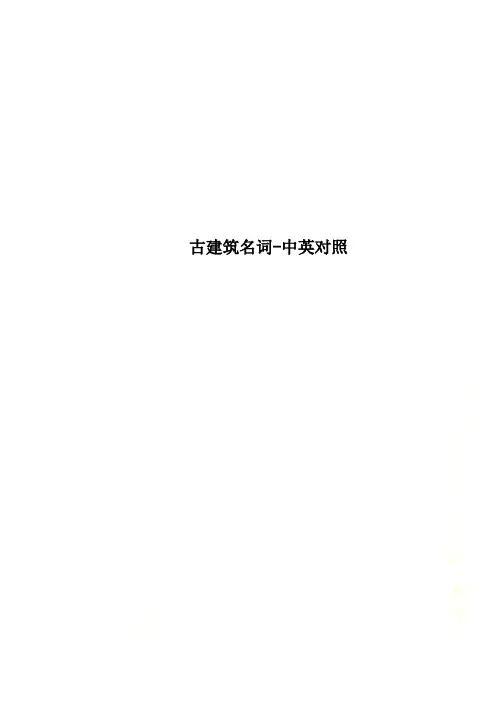
古建筑名词-中英对照信人: tjr99 (颐养), 信区: DESIGNPHD标题: 中国古代建筑及构造英文翻译发信站: 未建成BBS (Sun Mar 11 20:43:56 2007), 站内(全国自然科学名词审定委员会1996年公布)中国古代建筑及构造宫palace,temple殿hall厅hall又称「堂」室room房house亭pavilion台platform坛altar楼storied building*阁pavilion廊colonnade榭pavilion on terrace水榭waterside pavilion轩windowed veranda民居folk house四合院courtyard house寨stockaded village舫boat house阙que,watchtower牌楼pailou,decorated gateway 华表huabiao,ornamental pillar 塔pagoda硬山flush gable roof悬山overhanging gable roof歇山gable and hip roof庑殿hip roof四阿hip roof卷棚round ridge roof重檐double eave roof攒尖pyramidal roof园攒尖round pavilion roof大木wooden structure大式wooden frame with dougong小式wooden frame without dougong 大木作carpentry work小木作joinery work抬梁式构架post and lintel construction 穿斗式构架column and tie construction 井干式构架log cabin construction檐柱eave column金柱hypostyle column内槽柱hypostyle column唐代术语内柱hypostyle column宋代术语山柱center column角柱corner column唐、宋术语瓜柱short column脊瓜柱king post蜀柱king post宋代术语雷公柱suspended column帐杆suspended column宋代术语侧脚cejiao宋代术语卷杀entasis梭柱shuttle-shaped column宋代术语角背bracket由戗inverted V-shaped brace*手chashou,inverted V-shaped brace宋代术语柁墩wooden pier驼峰tuofeng,camel-hump shaped support宋代术语梁beam栿beam宋代术语月梁crescent beam三架梁3-purlin beam平梁3-purlin beam宋代术语四架梁4-purlin beam五架梁5-purlin beam四椽栿5-purlin beam宋代术语六架梁6-purlin beam七架梁7-purlin beam六椽栿7-purlin beam宋代术语九架梁9-purlin beam八椽栿9-purlin beam宋代术语单步梁one-step cross beam双步梁two-step cross beam挑尖梁main aisle exposed tiebeam乳栿rufu,beam tie宋代术语抱头梁baotou beam穿插枋penetrating tie角梁hip rafer桁purlin (used with dougong) 大式檩purlin (used without dougong) 小式槫purlin宋代术语脊桁ridged purlin大式脊檩ridged purlin小式脊槫ridged purlin宋代术语金桁intermediate purlin大式金檩intermediate purlin小式上中平槫intermediate purlin宋代术语老檐桁purlin on hypostyle大、小式,宋代术语正心桁eave purlin大式檐檩eave purlin小式下平槫eave purlin宋代术语额枋architrave(used with dougong)大式檐枋architrave(used with dougong)小式阑额architrave宋代术语由额垫板cushion board大式檐垫板cushion board小式枋tiebeam脊枋ridge tiebeam上金枋upper purlin tiebeam下金枋lower purlin tiebeam老檐枋eave tiebeam大式,指檐口构造檐枋eave tiebeam小式,指檐口构造顶椽top rafter脑椽upper rafter*花架椽intermediate rafter檐椽eave rafter飞檐椽flying rafter飞子flying rafter宋代术语连檐eave edging瓦口tile edging颔版tile edging宋代术语举架raising the purlin举析raising the purlin宋代术语步架horizontal spacing between purlins 材cai栔qi分fen斗口doukou,mortise of cap block斗拱dougong,bracket set斗dou,bracket set升block with cross mortise大斗cap block栌斗cap block宋代术语拱gong,bracketarm翘flower arm,petal华拱flower arm宋代术语昂ang,lever槽升子center block齐心斗center block宋代术语三才升small block十八斗connection block交互斗connection block宋代术语正心拱axial bracket arm泥道拱axial bracket arm宋代术语瓜拱oval arm瓜子拱oval arm宋代术语万拱long arm慢拱long arm宋代术语厢拱regular arm令拱regular arm宋代术语单材拱outer-side bracket arm撑头small tie-beam枋small tie-beam宋代术语耍头nose攒set of bracket柱头科bracket set on columns柱头铺作bracket set on columns宋代术语平身科bracket sets between columns补间铺作bracket sets between columns宋代术语角科bracket set on corner转角铺作bracket set on corner宋代术语出extension of bracket出跳extension of bracket宋代术语跴cai跳tiao宋代术语雀替sparrow brace搏缝板gable eave board搏缝版gable eave board宋代术语木装修joiner's work外檐装修exterior finish work内檐装修interior finish work 框槛door frame槛stud抱框jamb on door or window 格栅partition door抹头window stool棂子grill裙板panel槛窗sill wall window榻板window sill支摘窗removable window门枕door bearing门簪decorative cylinder门跋door knocker门钉decorative nails on door leaf 门枕石bearing stone抱鼓石drum-shaped bearing stone 天花ceiling帽儿梁lattice framing支条lattice framing井口天花compartment ceiling海墁天花flat ceiling藻井caisson ceiling罩shelf龛niche博古架antique shelf瓦石作masonry檐墙eave wall廊墙partition wall扇面墙horizontal partition wall 隔断墙vertical partition wall槛墙sill wall樨头gable wall head挑檐石cantilever stone on eave五花山墙stepped gable wall拔磉corbel,hanging over叠涩corbel,hanging over宋代术语角柱石corner pier阶条石rectangular stone slab压阑石rectangular stone slab宋代术语台阶steps踏道steps宋代术语踏垛step踏step宋代术语斗板石intermediate pier垂带drooping belt stone副子drooping belt stone宋代术语象眼triangular space御路yulu,imperial path羌差ramp须弥座xumizuo圭角guijiao上枋upper fillet and fascia下枋lower fillet and fascia上袅upper cyma,recta下袅lower cyma,reversa束腰suyao钩栏balustrade宋代术语单钩栏single frieze balustrade宋代术语垂台钩栏double frieze balustrade望柱baluster望柱头baluster capital栏版frieze panel华版frieze panel地伏plinth stone寻杖handrail宋代术语柱顶石capital stone柱础column base踬zhi碑碣stone tablet*屃bixi,stone turtle宋及宋前术语趺fu,stone turtle清代术语石像生stone animal石人stone human statue筒瓦round tile板瓦flat tile青瓦black tile 脊瓦ridge tile琉璃瓦glazed roof tile勾头eave tile滴水drip tile瓦当tile end,eave tile with pattern正吻zhengwen鸱尾chiwei宋及宋前术语正脊main ridge垂脊diagonal ridge for hip roof,vertical ridge for gable roof戗脊diagonal ridge for gable and hip roof博脊horizontal ridge for gable and hip roof仙人celestial being走兽animal砖雕brick carving彩画colored pattern,colored drawing苏式彩画Suzhou style pattern旋子彩画tangent circle pattern和玺彩画 dragons pattern天花彩画 ceiling pattern箍头 end portion of painted beam藻头intermediate portion of painted beam 枋心central portion of painted beam点金gold pointing退晕color change沥粉embossed painting 贴金gold foil painting。

信人: tjr99 (颐养), 信区: DESIGNPHD标题: 中国古代建筑及构造英文翻译发信站: 未建成BBS (Sun Mar 11 20:43:56 2007), 站内(全国自然科学名词审定委员会1996年公布)中国古代建筑及构造宫palace,temple殿hall厅hall又称「堂」室room房house亭pavilion台platform坛altar楼storied building*阁pavilion廊colonnade榭pavilion on terrace水榭waterside pavilion轩windowed veranda民居folk house四合院courtyard house寨stockaded village舫boat house阙que,watchtower牌楼pailou,decorated gateway华表huabiao,ornamental pillar塔pagoda硬山flush gable roof悬山overhanging gable roof歇山gable and hip roof庑殿hip roof四阿hip roof卷棚round ridge roof重檐double eave roof攒尖pyramidal roof园攒尖round pavilion roof大木wooden structure大式wooden frame with dougong小式wooden frame without dougong大木作carpentry work小木作joinery work抬梁式构架post and lintel construction 穿斗式构架column and tie construction 井干式构架log cabin construction檐柱eave column金柱hypostyle column内槽柱hypostyle column唐代术语内柱hypostyle column宋代术语山柱center column角柱corner column唐、宋术语瓜柱short column脊瓜柱king post蜀柱king post宋代术语雷公柱suspended column帐杆suspended column宋代术语侧脚cejiao宋代术语卷杀entasis梭柱shuttle-shaped column宋代术语角背bracket由戗inverted V-shaped brace*手chashou,inverted V-shaped brace宋代术语柁墩wooden pier驼峰tuofeng,camel-hump shaped support宋代术语梁beam栿beam宋代术语月梁crescent beam三架梁3-purlin beam平梁3-purlin beam宋代术语四架梁4-purlin beam五架梁5-purlin beam四椽栿5-purlin beam宋代术语六架梁6-purlin beam七架梁7-purlin beam六椽栿7-purlin beam宋代术语九架梁9-purlin beam八椽栿9-purlin beam宋代术语单步梁one-step cross beam双步梁two-step cross beam挑尖梁main aisle exposed tiebeam乳栿rufu,beam tie宋代术语抱头梁baotou beam穿插枋penetrating tie角梁hip rafer桁purlin (used with dougong) 大式檩purlin (used without dougong) 小式槫purlin宋代术语脊桁ridged purlin大式脊檩ridged purlin小式脊槫ridged purlin宋代术语金桁intermediate purlin大式金檩intermediate purlin小式上中平槫intermediate purlin宋代术语老檐桁purlin on hypostyle大、小式,宋代术语正心桁eave purlin大式檐檩eave purlin小式下平槫eave purlin宋代术语额枋architrave(used with dougong)大式檐枋architrave(used with dougong)小式阑额architrave宋代术语由额垫板cushion board大式檐垫板cushion board小式枋tiebeam脊枋ridge tiebeam上金枋upper purlin tiebeam下金枋lower purlin tiebeam老檐枋eave tiebeam大式,指檐口构造檐枋eave tiebeam小式,指檐口构造顶椽top rafter脑椽upper rafter*花架椽intermediate rafter檐椽eave rafter飞檐椽flying rafter飞子flying rafter宋代术语连檐eave edging瓦口tile edging颔版tile edging宋代术语举架raising the purlin举析raising the purlin宋代术语步架horizontal spacing between purlins材cai栔qi分fen斗口doukou,mortise of cap block 斗拱dougong,bracket set斗dou,bracket set升block with cross mortise大斗cap block栌斗cap block宋代术语拱gong,bracketarm翘flower arm,petal华拱flower arm宋代术语昂ang,lever槽升子center block齐心斗center block宋代术语三才升small block十八斗connection block交互斗connection block宋代术语正心拱axial bracket arm泥道拱axial bracket arm宋代术语瓜拱oval arm瓜子拱oval arm宋代术语万拱long arm慢拱long arm宋代术语厢拱regular arm令拱regular arm宋代术语单材拱outer-side bracket arm撑头small tie-beam枋small tie-beam宋代术语耍头nose 攒set of bracket柱头科bracket set on columns柱头铺作bracket set on columns宋代术语平身科bracket sets between columns补间铺作bracket sets between columns宋代术语角科bracket set on corner转角铺作bracket set on corner宋代术语出extension of bracket出跳extension of bracket宋代术语跴cai跳tiao宋代术语雀替sparrow brace搏缝板gable eave board搏缝版gable eave board宋代术语木装修joiner's work外檐装修exterior finish work内檐装修interior finish work框槛door frame槛stud抱框jamb on door or window格栅partition door抹头window stool棂子grill裙板panel槛窗sill wall window榻板window sill支摘窗removable window门枕door bearing门簪decorative cylinder门跋door knocker门钉decorative nails on door leaf 门枕石bearing stone抱鼓石drum-shaped bearing stone 天花ceiling帽儿梁lattice framing支条lattice framing井口天花compartment ceiling海墁天花flat ceiling藻井caisson ceiling罩shelf龛niche博古架antique shelf瓦石作masonry檐墙eave wall廊墙partition wall扇面墙horizontal partition wall隔断墙vertical partition wall槛墙sill wall樨头gable wall head挑檐石cantilever stone on eave五花山墙stepped gable wall拔磉corbel,hanging over叠涩corbel,hanging over宋代术语角柱石corner pier阶条石rectangular stone slab压阑石rectangular stone slab宋代术语台阶steps踏道steps宋代术语踏垛step踏step宋代术语斗板石intermediate pier垂带drooping belt stone副子drooping belt stone宋代术语象眼triangular space御路yulu,imperial path羌差ramp须弥座xumizuo圭角guijiao上枋upper fillet and fascia下枋lower fillet and fascia上袅upper cyma,recta下袅lower cyma,reversa束腰suyao钩栏balustrade宋代术语单钩栏single frieze balustrade宋代术语垂台钩栏double frieze balustrade望柱baluster望柱头baluster capital栏版frieze panel华版frieze panel地伏plinth stone寻杖handrail宋代术语柱顶石capital stone柱础column base踬zhi碑碣stone tablet*屃bixi,stone turtle宋及宋前术语趺fu,stone turtle清代术语石像生stone animal石人stone human statue筒瓦round tile板瓦flat tile青瓦black tile 脊瓦ridge tile琉璃瓦glazed roof tile勾头eave tile滴水drip tile瓦当tile end,eave tile with pattern正吻zhengwen鸱尾chiwei宋及宋前术语正脊main ridge垂脊diagonal ridge for hip roof,vertical ridge for gable roof 戗脊diagonal ridge for gable and hip roof博脊horizontal ridge for gable and hip roof仙人celestial being走兽animal砖雕brick carving彩画colored pattern,colored drawing苏式彩画Suzhou style pattern旋子彩画tangent circle pattern和玺彩画 dragons pattern天花彩画 ceiling pattern箍头 end portion of painted beam藻头intermediate portion of painted beam 枋心central portion of painted beam点金gold pointing退晕color change沥粉embossed painting贴金gold foil painting。

中国古建筑演讲英语作文Good morning, everyone,Today, I am thrilled to have the opportunity to speak to you about a topic that has always fascinated me: the ancient architecture of China. This rich heritage is not only a testament to the country's long and storied history but alsoa marvel of engineering and artistic skill that continues to inspire awe and admiration.The Evolution of Chinese Architectural StyleChina's architectural history spans over four millennia, andit has seen a variety of styles and influences. From the Neolithic period to the dynastic eras, each age has left its mark on the country's architectural landscape. The earliest structures were simple, made of earth and thatch, but asChina's civilization grew, so did its architectural ambitions.The Shang Dynasty (1600–1046 BC) saw the construction ofmore permanent structures, including palaces and ritual sites. The Tang Dynasty (618–907 AD) is often considered the golden age of Chinese architecture, with the construction of the Great Buddha at Leshan and the iconic Big Wild Goose Pagoda.Key Features of Ancient Chinese ArchitectureOne of the most distinctive features of Chinese ancientarchitecture is its emphasis on symmetry and balance,reflecting the philosophical principles of harmony withnature and the universe. The use of wood as a primarybuilding material is another hallmark, with wooden beams, columns, and brackets supporting the structure and allowingfor flexibility in design.The intricate detailing in the form of carvings, paintings, and ceramic tiles is not just for aesthetic appeal but also carries symbolic meanings. For instance, dragons symbolize imperial power, while phoenixes represent grace and virtue.The Role of Religion and PhilosophyReligion and philosophy have played a significant role in shaping Chinese architecture. Confucianism, Taoism, and Buddhism have all influenced the design and purpose of buildings. Temples, pagodas, and monasteries are not just places of worship but also centers of learning and meditation.The Forbidden City in Beijing, for example, is a masterpieceof Chinese palatial architecture and was the imperial palace for the Ming and Qing dynasties. Its layout and design are based on the principles of feng shui, aiming to create a harmonious environment.Preservation and Modern InterpretationThe preservation of ancient Chinese architecture is achallenge due to natural decay, human intervention, and modernization. However, efforts are being made to restore andmaintain these historical structures. At the same time, modern architects are drawing inspiration from traditional designs, creating a fusion of old and new that pays homage to the past while looking towards the future.In conclusion, ancient Chinese architecture is a treasure trove of cultural heritage that offers a unique perspective on the country's past. It is a blend of form and function,art and philosophy, and a testament to the ingenuity of its builders. As we continue to explore and learn from these ancient structures, they serve as a bridge between the past and the present, reminding us of our roots and inspiring us to build a future that honors our history.Thank you for your attention, and I look forward to any questions or discussions you may have on this fascinating subject.。
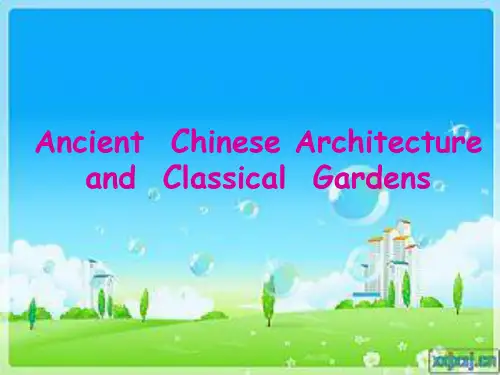
中国古典园林—---—-classical Chinese garden中国传统园林———-———traditional Chinese garden中国古代园林—-——--—ancient Chinese garden中国山水园———--———--Chinese mountain and water garden帝王宫苑-—---—--—imperial palace garden皇家园林-———-————-royal garden私家园林———--—————-private garden江南园林-——-——----————garden on the Yangtze Delta西方古典园林—-—--—-—--——---western classical garden英国式园林——--—---—--—--——-——- English style garden中英混合式园林--—-—-——-———-—Anglo—Chinese style garden意大利式园林----——-——--------- Italian style garden西班牙式园林--—-——--——-———-—Spainish style garden法兰西式园林——--—-—--———--—-——French style garden勒诺特尔式园林—---—-—-———————Le Notre\’s style garden文艺复兴庄园-—--——--—--———————-—Renaissance style garden洛可可式园林——-——--——--—--—---—-——-Rococo style garden巴洛克式园林--———--——————————-——-Baroque style garden庄园—-------—-——-------—-—-—--manor,villa garden廊柱园—--—--—-—-—-—--—--—--—-peristyle garden,patio绿廊-—---—--—-—--—--—-—------—-—xystus迷阵-———————————-—-——-—-———--—---maze,labyrinth灵囿-—-—————---—-—-———————--——Ling You Hunting Garden 周代术语灵沼——--—--—-—---——Ling Zhao Water Garden 周代术语灵台——--—-----—-———Ling Tai Platform Garden 周代术语阿房宫—-——-----—-—-E—Pang Palace 秦代术语上林苑-----————-——--—Shang—Lin Yuan 汉代术语未央宫-———-----—-———-Wei-Yang Palace 汉代术语洛阳宫—--—————--—--———Luoyang Palace 魏代术语华清宫———-—-———-—-——-—Hua—Qing Palace 唐代术语艮岳—--——--—----——--—--Gen Yue Imperial Garden 宋代术语圆明园-—-———-——-——--—-Yuan—Ming Yuan Imperial Garden颐和园--——-——-——————--—--Yi-HE Yuan Imperial Garden承德避暑山庄—-—-—-—-----—-—Chengde Imperial Summer Resort苏州园林—-————--—---—-—--—-——-Suzhou traditional garden悬园--—--——————Hanging Garden 又称“悬空园”,“架高园”.英国皇家植物园-—----———-—Royal Botanical Garden,Kew garden 又称“邱园"。
古建筑英文小作文Ancient Architecture。
Ancient architecture is a symbol of the rich cultural heritage of a country. It is an important part of history and culture, and it reflects the social, economic, and political conditions of the time period in which it was built. Ancient architecture is not only a source of pride for the people of a country, but it also attracts tourists from all over the world.China, for example, is a country with a long history and a rich cultural heritage. The ancient architecture in China is world-renowned for its unique style and exquisite craftsmanship. The Great Wall of China, the Forbidden City, and the Temple of Heaven are just a few examples of the ancient architecture that can be found in China. These buildings not only represent the architectural achievements of ancient China, but they also provide a glimpse into the lives of the people who built them.The Great Wall of China is one of the most famous ancient structures in the world. It was built over 2,000 years ago, and it stretches over 13,000 miles. The wall was built to protect China from invaders, and it is a testament to the ingenuity and determination of the Chinese people. The wall is made of stone, brick, tamped earth, and other materials, and it is a masterpiece of ancient engineering.The Forbidden City is another famous example of ancient architecture in China. It was built during the Ming and Qing dynasties, and it served as the imperial palace for over 500 years. The Forbidden City is a massive complex of buildings, and it is renowned for its grandeur and beauty. The palace is a perfect example of traditional Chinese architecture, and it is a must-see for anyone interested in ancient Chinese culture.The Temple of Heaven is a third example of ancient architecture in China. It was built in the 15th century, and it served as a place of worship for the emperors of the Ming and Qing dynasties. The temple is a stunning exampleof ancient Chinese architecture, and it is renowned for its intricate design and beautiful colors.In conclusion, ancient architecture is an important part of history and culture, and it provides a window into the lives of the people who built it. The ancient architecture in China is world-renowned for its uniquestyle and exquisite craftsmanship, and it is a source of pride for the people of China. The Great Wall of China, the Forbidden City, and the Temple of Heaven are just a few examples of the ancient architecture that can be found in China, and they are a must-see for anyone interested in ancient Chinese culture.。